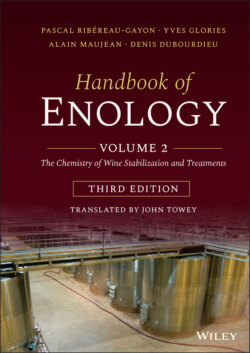Читать книгу Handbook of Enology, Volume 2 - Pascal Ribéreau-Gayon - Страница 42
1.7.5 Preventing Calcium Tartrate Problems
ОглавлениеCalcium tartrate is a relatively insoluble salt. It is 10 times less soluble than potassium bitartrate (see Section 1.5.1, Table 1.11). Independently of any accidental contamination, calcium added in the form of calcium bentonite for treating must or wine, calcium carbonate for deacidification purposes, or even as a contaminant in sucrose used for chaptalization, may cause an increase in the calcium tartrate content of wine. Combined with an increase in pH, this may put the wine into a state of supersaturation for this salt, leading to crystal deposits. Robillard et al. (1994) reported that crystallization of CaT was even observed in Champagne base wines with a particularly low pH. Ribéreau‐Gayon et al. (1977) considered there to be a real risk of tartrate deposits in the bottle when the calcium content is over 60 mg/l in red wine and 80 mg/l in white wine.
Stabilizing wines to prevent precipitation of calcium tartrate is not easy, as the crystallization of potassium bitartrate does not induce that of calcium tartrate, despite the fact that these two salts should logically crystallize together as they have the same crystal systems. In contrast, crystallization of CaT may induce that of KHT. The prevention of calcium tartrate precipitation is further complicated by the fact that the solubility of CaT (Postel, 1983) is not very temperature sensitive. Thus, CaT is just three times more soluble at 20°C than at −4°C.
Furthermore, according to Abgueguen and Boulton (1993), although the crystallization kinetics of CaT should be faster than those of KHT, the time required for spontaneous nucleation of CaT is much longer. It is therefore easier to understand why calcium tartrate precipitation generally occurs in wine after several years of aging.
On the basis of research into potassium bitartrate (Figure 1.11), Vallée (1995) used measurements of electrical conductivity to define the width of the domain of supersaturation expressed in degrees Celsius, as well as the calcium tartrate saturation temperature of various types of wines. The low solubility of calcium tartrate indicates that saturation temperatures are likely to be much higher than those of potassium bitartrate.
To avoid the risk of calcium tartrate precipitation, the saturation temperature of white and rosé wines and vins doux naturels must be lower than 26°C to ensure that calcium tartrate deposits will not be formed if the wine is kept at 2°C for one month. The calcium tartrate saturation temperature for red wines must be below 35°C.
According to Postel (1983), the addition of 100 mg/l of metatartaric acid is capable of stabilizing a wine stored at 4°C for several months, so it does not suffer from crystalline deposits of CaT. Furthermore, the use of racemic acid (D‐L‐tartaric acid) or calcium L‐tartrate has been suggested for eliminating excess calcium (Ribéreau‐Gayon et al., 1977). In both cases, the precipitation of calcium racemate, a highly insoluble salt, totally eliminates the cation. The treatment's effectiveness depends on the colloid content of the wine, as colloids hinder precipitation of the salt. These treatments are used to varying degrees in different wine regions depending on the types of wines produced.
Finally, ion exchange (Section 12.4.3) and electrodialysis (Section 12.5) are also processes for preventing calcium tartrate deposits.
